You must think and act like a pro to trade forex like a pro. Trading experts didn’t just become professionals overnight. They learned trading techniques to help them understand the market and its operations.
To become an expert, one must have insight into the various trading techniques; and understand the market operation principles. Trading techniques help traders analyse the market procedure and the steps involved in trading successfully. Experts are exceptional because of their mastery of various trading techniques. Here you’ll learn about different trading techniques and discover the techniques experts use to top the trading chart. When you understand how to trade forex using different techniques experts use, you can also aim for the top spot in the trade forex charts!
Trading Techniques
A trading technique is a method or strategy used for buying and selling securities in the exchange market. It is the procedure used in determining market operations and decisions alongside indicators, market value, and analysis.
Trading techniques must be consistent and measurable to help determine future value in the exchange market. While trading techniques ensure that clear objectives and goals are created to achieve trading success, there are several trading techniques in the market. So, let’s dive into the different strategies experts use for their trades.
Multiple Time Frame Analysis
One of the best trading techniques experts use is multiple time frame analysis. This technique involves looking at a chart on multiple time frames to identify the trend. You can stay in trends longer using multiple time frames and avoid getting whipsawed out of trades.
The most common time frames that traders use are the daily, weekly, and monthly charts. By looking at all three of these time frames, you can better understand where the market is going. For example, if you see that the market is in an uptrend on the weekly chart but overbought on the daily chart, you know there is likely to be a pullback soon.
The Three Most Popular Multiple Time FrameTrading Techniques
1. Day trading: Day trading is a strategy where you open and close positions within the same day. This technique is popular among traders who want to take advantage of short-term market movements.
2. Swing trading: Swing trading is a strategy where you hold positions for a few days or weeks to capture larger market swings. This technique is popular among traders who want to capture profits in rising and falling markets.
3. Position trading: Position trading is a strategy where you hold positions for months or even years to capture long-term trends in the market. This technique is popular among traders who want to take advantage of major market moves.
Fibonacci Retracements
Fibonacci retracements are another popular trading technique that experts use. This technique uses Fibonacci ratios to identify support and resistance levels. Traders often use Fibonacci ratios to place stop losses and take profits.
The most common Fibonacci ratios are 23%, 38%, 50%, and 61%. To find Fibonacci retracement levels, you first need to identify the high and low of a move. Then, you use those highs and lows to calculate the Fibonacci ratios. For example, if the high was 1.2500 and the low was 1.2400, then the 23% Fibonacci retracement level would be 1.2461, and the 38% Fibonacci retracement level would be 1.2476.
Japanese Candlesticks
Japanese candlesticks are another popular trading technique that experts use. Candlesticks provide information about market direction, momentum, and volatility. Candlesticks are created by plotting price action on a chart, and each Japanese candlestick represents a certain period, such as 1 minute, 5 minutes, 1 hour, etc.
There are many different candlestick patterns that traders can use to make decisions about their trades. Some popular candlestick patterns include hammer, hanging man, inverted hammer, shooting star, morning star, and evening star patterns.
These are just three of the many different trading techniques experts use to get an edge in the markets. While these techniques can be helpful, it’s important to remember that no single technique is guaranteed to work all the time. The key is to find what works for you and stick with it.
How to Choose the Best Trading Technique for You
Now that you know a little bit more about the three most popular trading techniques, let’s take a look at how to choose the best one for you. When making your decision, there are three key factors you should consider:
- Your time horizon: How long do you plan on holding your position? If you’re looking to take advantage of short-term market movements, then day trading may be your best option. On the other hand, position trading may be a better fit if you’re looking to capture longer-term trends.
- Your risk tolerance: How much risk are you willing to take on? Day trading generally involves higher risks than swing or position trading since your positions are only open for a short time. Swing and position trading involves lower risks since your positions are open for longer periods.
- Your capital requirements: How much capital do you have available? Day trading generally requires more capital than swing or position trading since you need to cover the costs of commissions and fees associated with opening and closing multiple positions. Conversely, swing and position trading generally require less capital since you only need to cover the costs of commissions and fees associated with opening and closing fewer positions over a longer period.
By considering your goals, risk tolerance, and capital requirements, you can narrow down the field and find the best trading technique for your needs. So don’t wait any longer—get started today!





